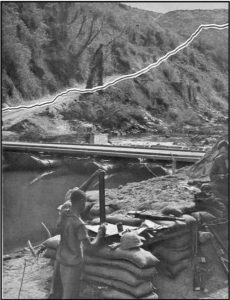West Point is home to me. I was born there and spent fifteen of my first twenty-two years there. During childhood, I thought it was idyllic. Five other Army brats from my high school were going to go to the Military Academy, and convinced me to go, too. I thought it would be extremely tough, but would make me a better person, and it did. West Point was a level playing field, where success comes through perseverance and hard work, not from status beforehand. Besides the Ten Commandments, it is also my moral compass as stated in the motto “Duty, Honor, Country”. From my work as an Academy Admissions Officer, I’ve seen firsthand the political side of getting into West Point in the first place. My father was denied a nomination three years in a row because he didn’t have political connections. On the fourth try, his congressman directed a freshman congressman to nominate my dad, which he did. Dad finished first in his class and ultimately became a general.
My brother was nominated because of dad’s status as an active-duty soldier—not political. When my turn came, dad knew the drill. I prepped for a Civil Service Exam, scored 100%, got my congressman’s principal nomination, though he wanted to shunt me off to the Air Force Academy, and was admitted with a waiver for height. There is an instant bond with any other graduate because, though we might have come from different backgrounds, we all went through a very rigorous program. I remember one Superintendent saying that West Pointers don’t just meet standards, they set the standards. I met my wife there and worked there for another eleven years as a Department of the Army Civilian. I must say that working there as a civilian is far different from being a uniformed officer. Throughout a career in the Regular Army and Reserves the knowledge that I was a West Pointer spurred me on to do the best I could for our country.
What West Point Means To Me – Suzanne Rice
I didn’t know Bill when he was a cadet. My first glimpse of West Point might have been watching the old television program,” The West Point Story” from the 1950’s. (must have been impressive for a little girl to remember) My next encounter with West Point was years later when I was in Junior College in my hometown. In my class was an impressive young man from a nearby small town; he was taking classes as he awaited admission to West Point. I didn’t understand the admission process at the time, but it was clear to all who knew him that he was an extraordinary person – way better than the rest of us, so West Point must be a special place if he wanted to go. (It was with great sadness that I learned a few years later that after his graduation in 1970, he was killed in an accident on a jump during Airborne School only a few months after his graduation from West Point.) After Bill and I were married and were returning to the U.S. from Bill’s first assignment in Germany, I asked to visit West Point since we were nearby picking up our car that had been shipped home. It was February and Bill had no desire to go back, three years later, but as a new bride, I was able to convince him to take me – it was my first glimpse of the beauty of the place even during Gloom Period.
At that time, I didn’t know that Bill would later become a professor in the USMA Math Department for four years; it was then that I began to understand not just the physical beauty of the place, but I got to know the people there and understand the important mission to which they promise to give even their lives. After Bill’s unexpected death, I witnessed the amazing love and support that was offered by Bill’s classmates and other grads that we had come to know over Bill’s 27 years on active duty. They rallied around the family, especially our son, who was himself a cadet at the time. I have found that the graduates of West Point take the values of Duty, Honor, Country with them wherever they go, hold on to them and exemplify them as long as they live.
What West Point Means To Me – Janie Taylor
My memories of West Point come in four phases. First, there were the exciting dating days where trips from the University of Kentucky to see Mike were like fairy tale stories. I’d save up all year long to fly to New York and after a bus ride from Grand Central Station my handsome cadet would meet me at Thayer Gate and we’d have a whirlwind weekend of football, dances and, oh yes, Flirtation Walk!
This exciting courtship ended in a wedding in the Cadet Chapel the day after graduation and the next 11 years working together to serve the Army and our country stateside and abroad.
My next memories are of the years Mike was on the English Dept. faculty at West Point and we made more memories with new and old classmates and spouses. It was a wonderful world to raise two children in and for four years I could absorb the history, sacrifice, tradition and camaraderie that only the military can exude.
As we entered the autumn of our lives, we found the bond of the class alums overwhelming as we enjoyed cruises to Alaska and the Baltic Sea and a trip to Ireland. As Mike’s cancer progressed, the “Best Of The Line” gave him encouragement and his last weeks were full of pride for his ’69 brothers and peace that he led a life well done.
I now have my private memories. They are full of gratitude, smiles and pride that I got to share in the brotherhood of West Point’s Class of ’69. I have been blessed beyond belief.
Janie Taylor
The “Wow” Test – 1971
What’s the “Wow Test” and why does it matter to my business? Well, let me tell you a story.
The setting is the Vietnam-jungle; hot, talcum powder dust, dirt, the entire genus of ant – you get the picture. I am an armored cavalry platoon leader1
Providing security operations for Rome Plows (huge bulldozers made in Rome, GA specifically designed to create large swatches of open land in Vietnam jungle/heavy brush. Easier to spot enemy troop movements; less places to hide.) along with the rest of my troop.

Typically, my troop, E Troop, operated by rotating two platoons on the security mission with the Rome Plows while one platoon remained with the troop Headquarters to provide additional security and to perform maintenance on weapons, vehicles and of course the soldiers. This rotation scheme would put each platoon out in the bush for 4-5 days at a time performing day time patrols and night time ambushes. The platoon serving troop Headquarters security would always conduct inspections of vehicles and weapons at the end of the first day back with the troop to be sure they were 100% ready to return to the operational missions.
One morning, a multiple-tour veteran NCO challenged me to personally inspect his track and weapons that afternoon. The gauntlet was being thrown to see how much the new ‘Lt.’ knew. I accepted the dare.

All day the level of activity on his Sheridan tank was frenetic — honor was at stake here.

The hour of decision arrived, and I walked over to his vehicle, accepted his report and salute and climbed onto the vehicle, ready to impress that I knew a thing or two that they had overlooked. I navigated my way to the rear of the vehicle to begin the inspection at the engine compartment. Alas, all of the grill doors and decks that protected the engine were already removed to open the engine for easy access and inspection.
I stopped dead – not quite sure of what I was seeing. The engine before me looked like it belonged on the cover of Hot Rod magazine.

Spotless. Gleaming. Certain components painted blue; others red; exhaust pipe polished – it looked like a stock car engine on proud display by a NASCAR pit crew.
The only word I could say was “WOW!” And I thought: “Do I insult the crew by even checking the oil? Of course, it will be correct”. But I went through the motions and, as predicted, found no faults.
Same for the turret compartment – flawless – spotless -‘eat off the floor’ trite clean. Weapons – same. In my entire Army career in and out of countless tank turrets and other armored vehicles, I never again saw such a display of pride.

Well ‘so what’ you say? Here’s the ‘so what’. The Sheridan class of vehicle I inspected that day had a terrible reputation in Vietnam for unreliable fire control-sensitive to heat, humidity, dirt – that could quit firing after a few rounds. Not a good thing in a firefight. But this NCO’s vehicle never broke down, never quit the fight; typically, he expended all his basic load and then would maneuver to the side of another Sheridan that had malfunctioning systems, offload their main gun ammo onto his vehicle, and continue the fight. This scene repeated over and over.
The moral – individuals with that much pride will never let you down. Some days I cannot remember what I had for breakfast – but I have never forgotten the lesson that young NCO taught me that day 40 years ago.
So back to the original question – how is the ‘Wow’ Test relevant to you and your business? To answer, I simply ask the question: “How do you want to be perceived by your clients?” When your clients look at your product; your company vehicles; your employees dress and manners; your store layout; your back office organization, your presentations, you – everything – are they stopped in their tracks to think or say, “Wow — I’ve never seen anything or anyone that has shown so much pride in their work?” What does the mere appearance of these indicators say about your company and its ability to perform? “Wow!” with gusto is what you want — make that happen and watch your reputation as a company “that can be counted on” grow.

1Author’s footnote: My platoon was one of three platoons that made up E Troop, 2nd Squadron, 11th Armored Cavalry Regiment. My platoon was typical – ten armored vehicles; comprised of three Sheridan light tanks; six armored personnel carriers and one mortar carrier and manned by approximately 40 soldiers. The mortars were typically aggregated at the Troop Headquarters.
E Troop also had a headquarters platoon that comprised maintenance and supply teams, mess operations, and troop command vehicles and personnel. 2nd Squadron had three such troops – E, F and G Troops plus a Field Artillery battery of six 155 self-propelled howitzers (cannons), aviation assets and, of course, various maintenance, admin and supply activities. At this juncture in the war, 2nd Squadron was the only unit remaining of the 11th Armored Cavalry Regiment. The others had redeployed home in early 1971.
Invading Laos – 1971, Part 2
FIRST DAY
The next morning, we deployed around the LZ. Our small, “air mobile” earth-moving equipment, ¾ ton dump trucks, jeeps, M450 bulldozers, D5 bulldozer, and scrapers were broken down for sling loading. We were also sharing the assault lift with an infantry battalion of the 5th Infantry Division (Mechanized). The pathfinders (forward troops who controlled our aircraft loading) were all set.
Then, as I guess happens in war, chaos takes over. The sky was cloudy at dawn and the largest group of slicks (Huey helicopters) I had ever seen approached the LZ. They landed but had their numbers in the windows all mixed up. My guys shouted, “what do we do?” and I answered get on one of the birds as they were supposedly all going to the same place. We jumped on with our enormous rucks and weapons and lifted off.
Khe Sanh was actually on a plateau and as we looked at the hundreds of choppers of all kinds in the air, we could see that a low cloud cover had just lifted enough to provide a “tunnel” up the main valley along QL9. Our pilot turned slightly north and landed on a hill top. I asked what was up and he told me he could not risk the congestion and would wait until things cleared a bit. He was right — the air traffic was unreal. We broke out some C-rations and ate lunch at about 0800. We finally got clearance and went to Khe Sanh. I later found out that the XO (Executive Officer) had made it through and had listed our birds as “missing in action” for a while. I thought that news had better not get to Mary Ellen before it was corrected.
We landed on the old matted air-strip and jumped out. One of my NCOs, SSG Vance, was a short stocky guy and fell over on his back. The ruck was so heavy he could not right himself and was flailing around like a turtle. One of his guys was yelling “they got Sarge.” I recognized no rounds were heard and shouted, “He’s OK, help him up!”
We secured our area and met with the XO. The old Marine matted airfield was full of holes and had a destroyed sub-grade material base under matting which was the result of NVA bombardment in 1968. Using it for C130 landings would require taking it up and completely rebuilding it. It would become our air cavalry squadron’s helicopter landing area. The decision was made to build a new strip parallel and just south. We started to try to clear through the elephant grass and along the road using detectors looking for the “booby traps” – none were found. We did see some infantry guys loose legs to the Marine mines – nobody apparently had a map or location (which was doctrine in the Army) and the mines seemed to be all around.
The opening of QL9 was taking more time than planned. So, I was told we would work back toward our other platoons. We gathered our jeep and some ¾ ton dump trucks and assembled a D5 bulldozer. We started down the road from Khe Sanh to QL9. We decided to drop the rucksacks and take ammo, detectors, and weapons only. The sweep along the dirt road was too slow. The shrapnel in the ground from all the previous fighting gave readings every few feet – but contrary to our intelligence briefing we found no booby traps, nor did we encounter any NVA. I decided we had to do a “visual” sweep and get moving. The road was slightly overgrown but could be seen. I mounted the front of the jeep, my legs dangling over the grill, and told my driver, SP4 Martin (a great 19-year-old kid) to move out and stop immediately if I yelled. If I missed something, he would never know it, anyway. We made progress.
Just about dark we hit the intersection of the main road and LTC Rodolph landed in his LOH (Light Observation Helicopter). He told me the other platoons had put in the bridges and had approached the last site (bridge #36) before Khe Sanh some kilometers from my location. I needed to get there that night – in other words perform a night mine sweep and road repair in the dark through what may be an enemy infiltrated area. We would be on our own as there was no infantry support available. He said he would like to be with us on our endeavor but that division “needed him in Quang Tri” that night. He took off as the sun set. My platoon sergeant rendered his LOH a single finger salute as he flew away.
The road was an old French hard surface, probably a mixed bituminous treatment and overgrown, but findable. We set the D5 bulldozer to the front behind a couple of point troops to mark the way. The D5 had a light and we had the jeep and two ¾ ton dump trucks. The mufflers were off the trucks, so they sounded quite noisy. We certainly would sound intimidating as we moved along. At this point we really did not believe the bobby trap threat although our other platoon working farther east had taken a casualty from mines on the road.
We started off to make our link up. It was a sight — all our guys (about 35) chugging along behind the bulldozer and trucks making as much noise as possible. We probably sounded like an armor outfit. We hit some snags when we came to a spot that had been pulverized, probably in 1968, by B52 500lb bombs. The craters were quite large, and we had to snake a route around them.
(I witnessed only one such B52 raid in country. They were called “Arc Lights” and we had to be at least 4 kilometers from the target. You never heard the planes which flew from as far away as Guam, or the falling bombs. The ridge would simply erupt with explosions and you could see the condensing of the air from the shock waves around the explosion. It was said that if the NVA survived many were found dazed and bleeding from the ears.)
We then came to a spot where a number of folks were running around in the dark shouting in Vietnamese. We kept moving forward, they ran, and not a shot was fired! We speculated they were probably NVA support troops as there were not supposed to be any ARVN in the area yet.
Finally, we were moving downhill to the last bridge site. On the hill above, fires were burning from earlier air attacks and we heard what sounded like weapon discharge. We kept moving. I was in contact with John and Steve by radio and they were dug in along the road on the other side of the river. At this point Steve had only a few guys as many had dropped off at the other bridge sites. The old French bridge abutments were way too far apart for our helicopter- delivered bridge frame. We needed to blow some rock with demo charges to create abutments and use the bulldozer to cut a bypass to drop the bridge frame on. Steve and John had the panels to fill it out. We decided that placing charges in the dark and trying to survey the needed work was not a smart thing. My guys were exhausted, and we were concerned that whomever we had “met” along the way or was on the hill above might give us a problem. We made a one rope river crossing ala Ranger School and took refuge behind their positions and got a couple hours rest. We reported our link-up to battalion headquarters.
SECOND DAY
Just before first light, we re-crossed the river, secured our stuff, and planted the charges and cut the bypass. We blew the rock, used the bulldozer to help complete the makeshift abutments, and we called for the bridge. It had to be dropped in by a CH 54 crane.

I sent the bulldozer and the bulk of the platoon back along our route to fix the B52-cratered area so the tracks could pass. The path we used in the dark was quite serpentine.
About this time a slick (Huey helicopter) carrying a one-star general of the 5th Infantry Division (Mechanized) landed on the abutment. He was furious. His column was strung out and stopped all along QL 9 back to Quang Tri he said. When were we 101st Airborne Division idiots going to get the damn bridge completed? At this moment the crane with the bridge, accompanied by two cobra gunships, was orbiting the site awaiting clearance to bring the frame in. I kind of lost it and told him “Sir, as soon as we get that f*%$kin bird out of the way.” He glared, asked my name, and got in his chopper.
The bridge went in and Steve’s and John’s troops began filling the frame. I scrambled to catch up to my guys. We fixed the road at the cratered site as best we could and welcomed the first Mechanized Infantry vehicles as they came up the road. They had signs proclaiming to be the First to Khe Sanh – my guys took issue with the claim.
We returned to Khe Sanh and started the airbase construction phase. It was quite a couple of first days of the operation. Some of us would later get the Bronze Star with a “V” (for valor) as well as a Vietnamese Cross of Gallantry with Silver Star for the events of these days.
